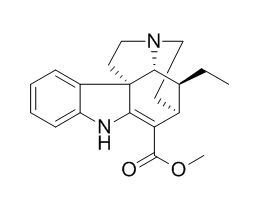Tubotaiwine
Tubotaiwine shows selective activity against L. infantum. Tubotaiwine and apparicine have affinity for adenosine receptors in the micromolar range and also have in-vivo analgesic activity in mice.
Inquire / Order:
manager@chemfaces.com
Technical Inquiries:
service@chemfaces.com
Tel:
+86-27-84237783
Fax:
+86-27-84254680
Address:
1 Building, No. 83, CheCheng Rd., Wuhan Economic and Technological Development Zone, Wuhan, Hubei 430056, PRC
Providing storage is as stated on the product vial and the vial is kept tightly sealed, the product can be stored for up to
24 months(2-8C).
Wherever possible, you should prepare and use solutions on the same day. However, if you need to make up stock solutions in advance, we recommend that you store the solution as aliquots in tightly sealed vials at -20C. Generally, these will be useable for up to two weeks. Before use, and prior to opening the vial we recommend that you allow your product to equilibrate to room temperature for at least 1 hour.
Need more advice on solubility, usage and handling? Please email to: service@chemfaces.com
The packaging of the product may have turned upside down during transportation, resulting in the natural compounds adhering to the neck or cap of the vial. take the vial out of its packaging and gently shake to let the compounds fall to the bottom of the vial. for liquid products, centrifuge at 200-500 RPM to gather the liquid at the bottom of the vial. try to avoid loss or contamination during handling.
Oxid Med Cell Longev2020, 12
Int Immunopharmacol.2020, 90:107268.
Korean J of Food Science&Technology 2017, 49(2):146-150
Oncotarget.2017, 8(53):90925-90947
Mol Med Rep.2022, 25(1):8.
Journal of Physiology & Pathology in Korean Medicine.2018, 32(2): 106-112
Agriculture2022, 12(12), 2173.
Korean J. of Food Sci. and Tech2016, 172-177
Sci Rep.2016, 6:25094
Korean Journal of Pharmacognosy2014, 113-120
Related and Featured Products
Nat Prod Commun. 2014 Aug;9(8):1075-80.
Antiparasitic indole alkaloids from Aspidosperma desmanthum and A. spruceanum from the Peruvian Amazonia.[Pubmed:
25233577]
Twenty-three indole alkaloids were isolated from Aspidosperma desmanthum and A. spruceanum.
METHODS AND RESULTS:
Alkaloids 1-4 were isolated from the leaves, 5-8 from the stem bark and 9-15 from the root bark of A. desmanthum. Alkaloids 5, 11, 16, 17 and 19 were isolated from the stem bark, 18 and 20-22 from the root bark and 23 from the flowers of A. spruceanum. Compounds 4, 14, and 15 have not been previously reported as natural products while 16 and 20 have been isolated for the first time from the genus Aspidosperma. Their structures were determined by spectroscopic techniques including 1D and 2D NMR experiments (COSY, NOESY, HSQC, HMBC). The antiparasitic activity of these compounds was tested against Trypanosoma cruzi and Leishmania infantum and their non-specific cytotoxicity on mammalian cells.
CONCLUSIONS:
The most active compounds were 10, 12, 13, and 14 from A. desmanthum, and 19, 21 and 22 from A. spruceanum. Aspidolimine (10) aspidocarpine (12) and Tubotaiwine (21) showed selective activity against L. infantum.
J Pharm Pharmacol. 1999 Dec;51(12):1441-6.
Isolation of opioid-active compounds from Tabernaemontana pachysiphon leaves.[Pubmed:
10678501]
A procedure for prefractionation of crude plant extracts by centrifugal partition chromatography (CPC) has been developed to enable rapid identification of known-positive compounds or false-positive compounds and to increase the chance of identifying minor unknown-active compounds. The study explored the use of CPC as a tool in the prefractionation step before investigation of bioactivity.
METHODS AND RESULTS:
Fractions obtained by CPC from an ethanolic extract of Tabernaemontana pachysiphon Stapf (Apocynaceae) were screened by means of an opiate-receptor-binding assay and an adenosine A1-receptor-binding assay. Fractions containing fatty acids, which had false-positive effects on the assay, were identified, as were unknown-positive fractions from which two opioid-active compounds, Tubotaiwine and apparicine, were subsequently isolated. The affinities (Ki) of Tubotaiwine and apparicine at the opiate receptor were 1.65 +/- 0.81 and 2.65 +/- 1.56 micromol, respectively.
Both alkaloids had analgesic activity in the abdominal constriction test in mice. CPC prefractionation led to the rapid isolation of two opioid-active compounds, Tubotaiwine and apparicine, from the unknown-positive fraction; false-positive fractions were rapidly identified.
CONCLUSIONS:
Both Tubotaiwine and apparicine had affinity for adenosine receptors in the micromolar range and also had in-vivo analgesic activity in mice.



